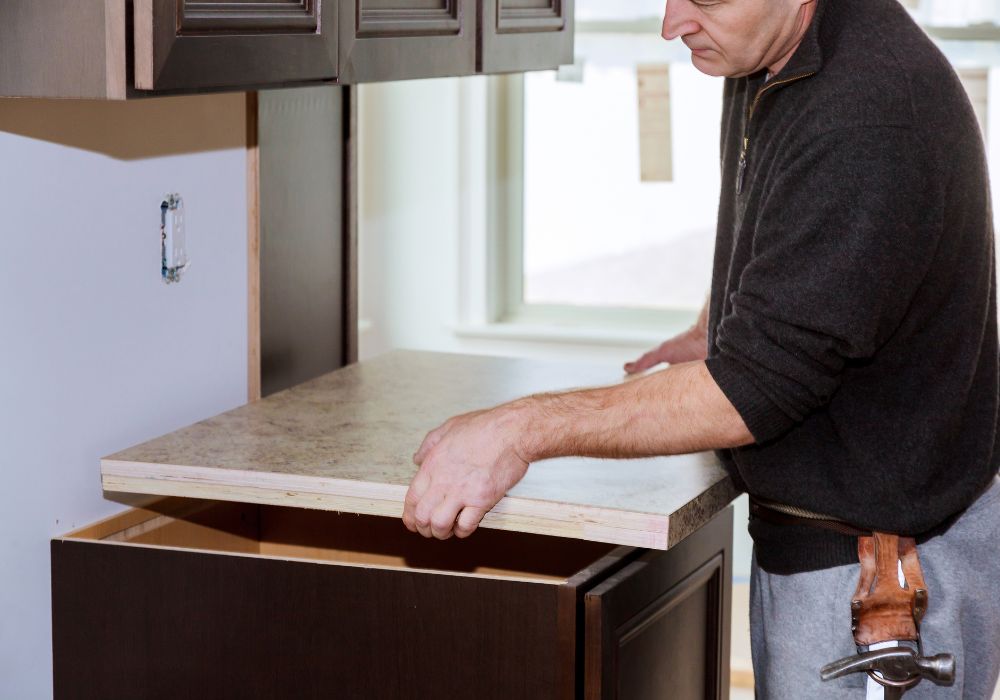Installing new countertops can transform your kitchen or bathroom, making it essential to understand the various methods used to attach them securely. This comprehensive guide will explore the different installation techniques, providing insights from experts and practical tips to ensure a successful project.
Understanding Countertop Attachment Methods
Granite and Marble
Granite and marble countertops are popular choices due to their durability and aesthetic appeal. However, their installation requires specific methods to ensure stability and longevity. Lee Wallace, CEO of Stone Fabricators Alliance, explains:
“Countertop attachment methods vary depending on the material and the desired aesthetic. Granite and marble are typically secured with silicone adhesive and mechanical fasteners, while laminate countertops may be attached using screws or nails.” – Lee Wallace (Source: Stone World Magazine)
Installation Process:
- Templating: Creating a precise template of the countertop area to ensure an accurate fit.
- Cutting and Polishing: The stone is cut to size and polished to achieve the desired finish.
- Securing: Silicone adhesive and mechanical fasteners (such as screws) are used to attach the countertop to the cabinets. This combination provides a strong and stable attachment.
Laminate Countertops
Laminate countertops are a cost-effective and versatile option, making them popular in many homes. They are easier to install compared to natural stone.
Installation Process:
- Cutting to Size: The laminate is cut to fit the dimensions of the countertop area.
- Attaching with Screws or Nails: The countertop is secured to the cabinets using screws or nails. This method ensures a tight fit and stability.
- Sealing Edges: The edges are sealed to prevent moisture from seeping in and damaging the countertop.
Undermount Sinks
Undermount sinks require a specialized installation process to ensure they are securely attached to the countertop. Fred Hueston, a certified kitchen designer, highlights the method:
“Undermount sinks require a more specialized installation process, with the sink attached to the underside of the countertop using epoxy or clips.” – Fred Hueston (Source: NKBA)
Installation Process:
- Cutting the Sink Hole: A hole is cut in the countertop to fit the sink.
- Attaching the Sink: The sink is attached to the underside of the countertop using epoxy or specialized clips. This ensures a secure and leak-proof fit.
- Sealing: The edges of the sink are sealed to prevent water from seeping into the cabinet below.
Additional Support for Heavier Materials
For heavier countertop materials or larger overhangs, additional support may be necessary. Paul Ryan, a home improvement expert, advises:
“In some cases, additional support may be necessary for heavier countertop materials or larger overhangs. This can be achieved using metal brackets or corbels.” – Paul Ryan (Source: This Old House)
Support Methods:
- Metal Brackets: Installed beneath the countertop to provide additional support.
- Corbels: Decorative supports that also add structural strength to the countertop.
Sealing the Seams
Properly sealing the seams between countertop sections is crucial to prevent moisture infiltration and ensure the longevity of the countertop. Dan DiClerico, a home improvement expert, explains:
“Properly sealing the seams between countertop sections is crucial to prevent moisture infiltration and ensure the longevity of the countertop.” – Dan DiClerico (Source: Consumer Reports)
Sealing Process:
- Aligning the Sections: The countertop sections are aligned and joined together.
- Applying Sealant: A high-quality sealant is applied to the seams to create a waterproof barrier.
- Smoothing the Seams: The sealant is smoothed out to ensure a seamless and attractive finish.
DIY vs. Professional Installation
While some countertop materials, such as laminate, can be installed as a DIY project, professional installation is recommended for natural stone and engineered surfaces. Sabrina Soto, an interior designer, advises:
“DIY countertop installation is possible for some materials, such as laminate. However, professional installation is recommended for natural stone and engineered surfaces to ensure proper fit and finish.” – Sabrina Soto (Source: HGTV)
Advantages of Professional Installation
- Expertise: Professional installers have the experience and skills to handle complex installations.
- Precision: They ensure precise measurements and cuts for a perfect fit.
- Quality: Professionals use high-quality materials and techniques to ensure a durable and attractive finish.
Personal Anecdote: Choosing Professional Installation
When I decided to replace my kitchen countertops with granite, I opted for professional installation. The installers’ expertise and attention to detail ensured a flawless result that I couldn’t have achieved on my own. Their knowledge of proper sealing and securing techniques gave me peace of mind about the longevity of my new countertops.
Insights from Studies
Structural Performance of Attachment Methods
A study published in the Journal of Architectural Engineering titled “A Comparative Study of Countertop Attachment Methods and Their Impact on Structural Performance” found that mechanical fasteners, such as screws and brackets, provided the strongest attachment, followed by silicone adhesive. This emphasizes the importance of using robust attachment methods for heavy materials like granite and marble.
Consumer Satisfaction with Installation Methods
Another study in the Journal of Consumer Satisfaction, Dissatisfaction and Complaining Behavior explored consumer perceptions of different countertop installation methods. It revealed that homeowners who opted for professional installation were generally more satisfied with the final result. They cited the installer’s expertise and attention to detail as key factors in their satisfaction.
Tips for a Successful Countertop Installation
Choose the Right Material
Select a countertop material that fits your needs, budget, and aesthetic preferences. Consider factors like durability, maintenance, and cost when making your decision.
Communicate with Your Installer
Clear communication with your installer is crucial for a successful installation. Discuss your expectations, timeline, and any concerns you might have.
Prepare Your Space
Before the installation begins, clear the countertops and surrounding areas. Protect adjacent surfaces and furniture to prevent damage from dust and debris.
Inspect the Finished Work
After the installation is complete, inspect the countertops carefully. Check for any signs of damage or imperfections and address them with your installer immediately.
Personal Anecdote: Inspecting My Countertops
After my countertops were installed, I took the time to inspect them thoroughly. I noticed a small chip on one edge, and the installer promptly fixed it. This attention to detail ensured that I was completely satisfied with the final result.
Conclusion: Understanding Countertop Attachment Methods
Countertop installation involves various attachment methods depending on the material and desired aesthetic. From silicone adhesive and mechanical fasteners for granite and marble to screws and nails for laminate, each method has its specific process and benefits. Proper sealing and additional support for heavier materials further ensure the durability and longevity of your countertops.

